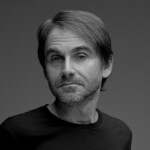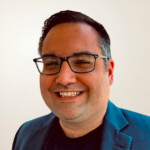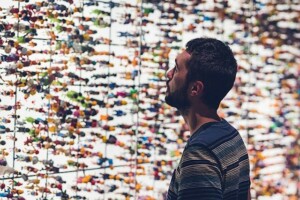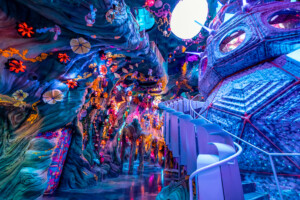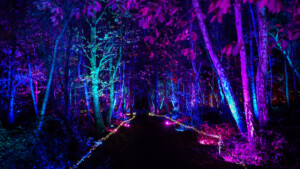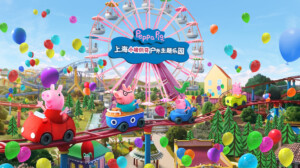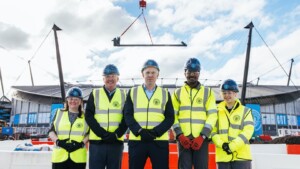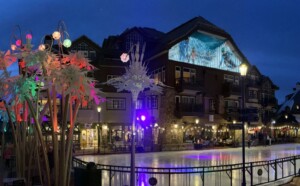There are no straight lines in Michael Reid’s career path. Founder of creative solutions company, Iconpath, he has worked all over the world absorbing influences and gathering material to add to what he calls the “repository of ideas in my head”. He talks to Blooloop about his past meanderings and the road ahead.
 Michael Reid was obsessed with Disney from an early age. His unconventional parents who ran their own company would take him out of school in winter – the slow season for their business- and they would go to Disneyworld for a month.
Michael Reid was obsessed with Disney from an early age. His unconventional parents who ran their own company would take him out of school in winter – the slow season for their business- and they would go to Disneyworld for a month.
“It was in such contrast to cold Canada. We stayed in Disney’s contemporary resort and I was drawn to the complete immersion in a different world.”
He moved to Florida as soon as he had finished university to work at Epcot in the cultural programme.
“I had this dream I would work my way up from the bottom and somehow find myself running the company. Of course, that doesn’t happen…”
Reid’s other passion at the time was musical theatre and, attracted by the city's theatres and museums, Reid moved to London. He bacame fascinated by the evolution of themed entertainment from the world expos in 1851 to icons like Disney.
“You could take a technique from a world expo in the 1900s, give it a new context and a new story and a new design and it would be just as relevant – these things never age. I was interested to see where I could take that, and how I could draw on it.”
“If you don’t tell people what you want to do, it’s never going to happen”

When his UK visa ran out, Reid moved to Sydney, where he found himself working for News Corporation. The job itself was rather dry and uninspiring, but Reid’s boss told him, “If you ever know what you want to do with your life, come and tell me and we’ll see what we can do.” A few days later, quite by chance and during a fire alarm, Reid got talking to some people who were working on a theme park in Sydney. He went back to his boss.
“I ended up working on a ticketing solution for that theme park, which at least got me closer to what I wanted… it was exciting to watch that park open. I had no creative input, but had at least been a minor contributor to the process. I realised that if you don’t tell people what you want to do, then it’s never going to happen. So I really started looking for ways to engage with projects that I wanted to do.”
However, he was diverted once again, this time by the dotcom explosion.
“There were billions of internet companies opening, and I kind of got swept up in doing that for a few years. It was an era of people giving you large opportunities for very few skills. So I rocketed up some non-existent corporate ladder, and it was useful because I gained business skills and a knack of handling management. I consoled myself at the time with the idea that the internet was a new form of creative outlet but in the back of my mind I never bought that. For me, online interaction can only ever be an overlay to improve a real experience.”
When the bubble burst, Reid found himself working in a telecommunications company of 200 people who were then laid off, leaving a team of five.
“I found myself in the middle of this really boring, dry culture. I decided again I would use this idea of telling people what I wanted to do. I’ve had a longstanding close relationship with Cirque du Soleil; when I went to Vegas with my parents I’d seen their very first shows at quite a young age. And so again, one day, I said: ‘If you ever end up doing a sponsorship  with Cirque du Soleil, I want to work on that.’ Literally the very next day someone came in and said: ‘Oh: you’ve been selected to be on the marketing committee. We’re sponsoring Cirque du Soleil; we need your input.’ So I ended up developing a number of interactive and brand extensions for this boring telecommunications company for their Cirque du Soleil sponsorship. Within a few months’ time I ended up leaving the telecommunications company to run the marketing agency that handled all Cirque du Soleil’s Asian Pacific touring. So again, whatever you ask for seems to happen.”
with Cirque du Soleil, I want to work on that.’ Literally the very next day someone came in and said: ‘Oh: you’ve been selected to be on the marketing committee. We’re sponsoring Cirque du Soleil; we need your input.’ So I ended up developing a number of interactive and brand extensions for this boring telecommunications company for their Cirque du Soleil sponsorship. Within a few months’ time I ended up leaving the telecommunications company to run the marketing agency that handled all Cirque du Soleil’s Asian Pacific touring. So again, whatever you ask for seems to happen.”
It was a leap of faith, and one that involved taking a 50% pay cut. But, Reid decided it was time to be true to his childhood ambitions. “I wanted to be closer to that creative process.”
Cirque du Soleil – “I was only selling other people’s dreams”
Reid was now devising live events and carnivals for Luna Park, Sydney, and managing all of Cirque du Soleil’s marketing and activations for their Asia Pacific tours as well as a number of small arts companies and projects in the Sydney Opera House and Belvoir Street Theatre: “…it was a really great portfolio of arts projects but I felt I was only selling other people’s dreams.”
“The shows are made in Montreal by Cirque de Soleil; they come to Australia; we would do something to promote them – create an event – but it was marketing, not creation. People were looking at me as the marketing agency, not as the creative. So, I had a mini mid-life crisis – I was in my thirties.”
Reid returned to Canada for a year but decided he was happier in Australia: “Canada, for me, is – and this is only my personal opinion – it’s so polite and obsessed with being nice that it’s very difficult – for me – to get a sense of: do you like the work that I’m creating? The culture in Australia is, I find, much more direct and people tell you if they don’t like something, and they’re also willing to give you a chance.”
“All I have is ideas and stories”
![]()
When he returned to Australia, he registered Iconpath.
“I started building my first terrible website and I really, really tried to clarify what it was I was selling. I can’t draw; I’m not an architect; all I have is ideas and stories. So how was I going to sell that?”
He joined IAAPA and built a website with minutes to spare before flying to Florida to attend his first conference, where he felt intimidated rather than inspired by the amazing design companies that show at IAAPA. Nevertheless, he was developing a sense of what he could be doing: Iconpath was taking shape. With a view to re-establishing his life in Australia, he applied for and got a job with George P Johnson, an internationally renowned events agency.
Within six months, he was added to the team creating the entertainment for the Australian Pavilion at Expo 2010 in Shanghai. Suddenly, he had resources at his disposal and could finally get ideas into a document then into a presentation. Although the pitch for the pavilion didn’t win, Reid was able to utilise the principles when, a week later, CISCO came on board as a client, not having committed to their pavilion and having chosen the same warehouse space that Reid’s team had been working on.
“I ran them through what I had done for my banking concept, evolving it into a telecommunications concept and they said – yes: we’ll do that. So, it was a case of ‘right place at the right time’. Well. And hard work.”
Rugby World Cup – “after that, my star had definitely risen”
![]()
His next opportunity grew out of his passion for rugby: he was given the chance to move to New Zealand to become the artistic director for the Rugby World Cup opening ceremony, with David Atkins, one of the world’s leading ceremony producers.
“It was an amazing project. A little disturbing because it was a year of work for a twenty-minute show, but it was spectacular: a projection-mapped field; a cast of a thousand people. I produced all of the digital content; all the on-screen content. I managed to create a team of music director, choreographer, set designer: it was quite amazing. When I came back to Australia after that, my star had definitely risen.”
Reid had met his partner in New Zealand; an Australian working on the projection side of the show. He had his own content and animation business in Melbourne, and Reid, ready for a change, made the decision to move to Melbourne. He continued to work for George P Johnson but within about twelve months decided to go alone: it was time for Iconpath to turn from a concept into an actual business.
“With a sort of synchronicity, my partner – who had an animation business – could visualise the stuff that was in my head, and do 3-D renders of spaces that I had been designing badly with a pencil. We merged our businesses and resources, and that was really the basis of what we have now.”
“My weird, unconventional journey has equipped me with valuable skills”
![]()
“So now there are seven of us, and it just works really, really well. We still do a lot of corporate stuff but we try and bring a storytelling and a design ‘eye’ to those experiences. I have this sort of repository of ideas within my head that I’ve seen around the world, and ideas of my own, too, and so my weird, unconventional journey of getting to this point – including the experience of working in the corporate sector, which I never meant to do – has equipped me with valuable skills … I used to regret that I hadn’t grown up in America and that I couldn’t just have started working in some West Hollywood design studio as soon as I was out of uni, but now when I look back I don’t think that would have worked.”
While a large proportion of Iconpath’s work is for corporates, Reid hopes to be focusing more on theme park and world expo design in the future.
"We’re exhibiting for the first time at IAAPA Asian Attractions Expo in Hong Kong in June 2015, and I plan to target Expo 2017 in Kazakhstan – I want to have a pavilion there – and, beyond that, Dubai in 2020. I think we have a capacity to empathise with both what the people who will be visiting want to see, and also to understand the cultural landscape in which everything sits.”
![]()
Reid concludes: “While we do draw from popular culture and what is contemporary, I don’t want to be faddish. A lot of my influences come from the 18th and 19th turn-of-the-century aesthetic… then there’s another window in the 60s I’m obsessed with: the jet age. And, I realised recently that both those eras are times when people thought technology could do anything; they were excited about the future. I think that’s probably what I’m responding to: the optimism. It’s what I got when I went to Disneyworld in the 70s – and now, I get glimpses that the world is starting out to turn out the way I pictured it then. Maybe this era we’re in now will also become one of my favourites. There is that feeling – we’re on a knife’s edge. Maybe things will get horrible; maybe things will be amazing. Hopefully, they’ll be amazing.”
Images: Epcot image courtesy Disney, Photographer – Gene Duncan



